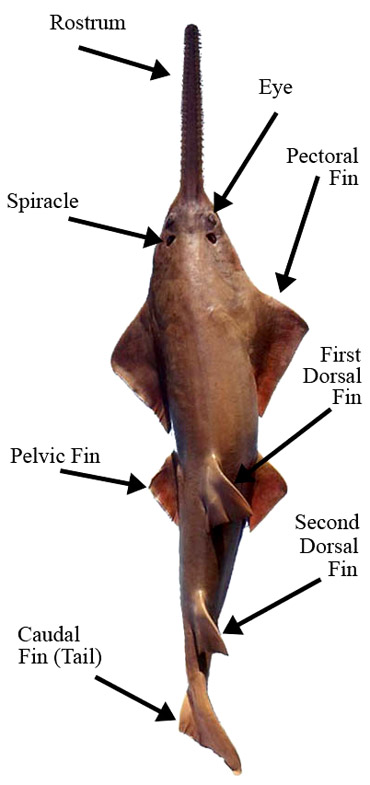 Rostrum – The rostrum is what gives the sawfish its common name. It is made of cartilage and is long and flat. The teeth along the side margins of the rostrum are not really teeth but rather modified scales. Different species of sawfish have rostrums and rostral teeth of different shapes and sizes. This anatomical feature is used during feeding and for defense. The rostrum is slashed in a side-to-side motion to dislodge invertebrates from the substrate and to stun schooling fishes. In addition, the sawfish can use its rostrum in defense against large predators such as sharks.
Rostrum – The rostrum is what gives the sawfish its common name. It is made of cartilage and is long and flat. The teeth along the side margins of the rostrum are not really teeth but rather modified scales. Different species of sawfish have rostrums and rostral teeth of different shapes and sizes. This anatomical feature is used during feeding and for defense. The rostrum is slashed in a side-to-side motion to dislodge invertebrates from the substrate and to stun schooling fishes. In addition, the sawfish can use its rostrum in defense against large predators such as sharks.
Eyes – The eyes are located near the top of the head, allowing the sawfish to see even when partially buried. Although the eyesight of sawfish is good, the waters where sawfish reside are often murky. This unique fish relies on other senses to help locate prey.
Spiracles – The spiracles are just posterior to the eyes. They are used to circulate water through the gills during times of inactivity for respiration.
Pectoral Fins – Sawfish have four different types of fins. The pectoral fins are used for lift and steering during swimming. There are two pectoral fins, each located along the sides of the sawfish, just behind the head. They consist of fan-shaped cartilage not quite extending to the margins. There is very little fat and muscle inside each fin.
Dorsal Fins – Sawfish have two dorsal fins which aid in stabilization. The term “dorsal” refers to the back or upper surface, giving rise to the name of these fins.
Pelvic Fins – The pelvic fins are also used for stabilization. Appendages at the base of pelvic fins on male specimens are referred to as claspers. Claspers are male reproductive organs.
Caudal Fin – The caudal fin, also referred to as the tail, is used to propel the sawfish forward during swimming. There is a lot of variability in the shape of the caudal fin among sawfish species.